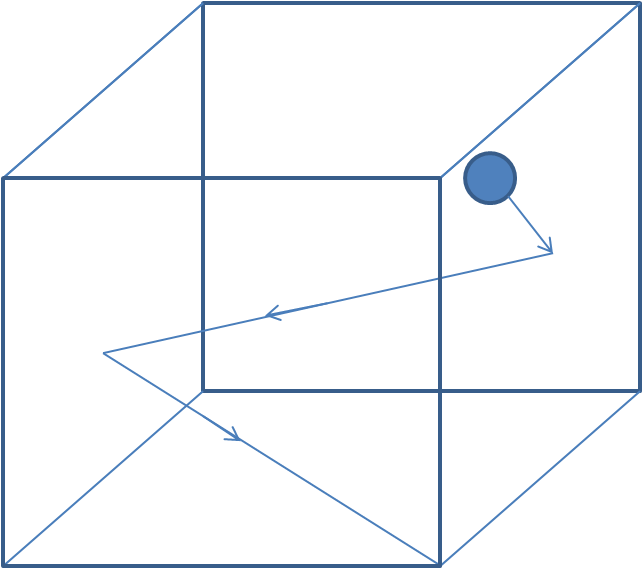From 2-D to 3-D

In a cubical room in 3-D coordinate space a ball is projected from point ( ) such that it collides with the room at ( ) and bounces of the walls repeatedly till it strikes one of the corners of room. Find the number of collisions the ball made with walls of the room before the ball finally strikes a corner.
Details and assumptions
1) The coordinates of the corners of the room are (0,0,0) ,(1,0,0) ,(0,1,0) ,(0,0,1) ,(0,1,1) ,(1,0,1) ,(1,1,0) ,(1,1,1).
2) The room is gravity free .
3) All collisions with the walls of the room are elastic.
4) The ball and corners of the room are point sized i.e. ball must strike the corner exactly.No near cases must be considered.
5) While counting the number of collisions also count the first collision i.e. collision at ( )
This problem is original and is inspired by This problem .
The answer is 9.
This section requires Javascript.
You are seeing this because something didn't load right. We suggest you, (a) try
refreshing the page, (b) enabling javascript if it is disabled on your browser and,
finally, (c)
loading the
non-javascript version of this page
. We're sorry about the hassle.
The problem which looks complicated can be solved easily by a specific approach which I found after solving Let`s play carrom.
Let`s assume that there are no walls and the ball is following a straight path instead of being reflected.
Also assume that there are infinite rooms,coordinates of whose corners are integers and they too have no walls!.
Now,when the ball strike corner of imaginary room then it will also strike corner of real room.
Here is an example to show my point.
So,the equation of line along which ball will travel will be given by joining
( 4 1 , 0 , 2 1 ) and ( 1 3 5 , 1 3 3 , 1 )
7 x − 4 1 = 1 2 y = 2 6 z − 2 1 = r ( s a y )
Now, only thing left to do is to find smallest integer coordinates which will be satisfied by line.
We have x=7r+ 4 1 , y=12r , z=26r+ 2 1
By finding smallest integer solution which satisfy above condition we`ll have r= 4 1 (It is easy to find try yourself)
∴ Coordinates are (2,3,7) and number of collisions will be equal to number of planes crossed =
2 − 1 + 3 − 1 + 7 − 1 = 9 (since we do not have to count the corner in collision)
For those who are not convinced by above solution ,coordinates of points of collision are ( 1 3 5 , 1 3 3 , 1 ) , ( 2 6 1 7 , 1 3 9 , 0 ) , ( 6 5 , 1 , 3 2 ) , ( 1 3 1 2 , 1 3 1 1 , 1 ) , ( 1 , 7 5 , 7 5 ) , ( 2 6 2 1 , 1 3 5 , 0 ) , ( 1 2 7 , 0 , 6 5 ) , ( 1 3 7 , 1 3 1 , 1 ) , ( 2 6 7 , 1 3 7 , 0 ) , ( 0 , 1 , 1 )